cooling YAMAHA WR 250F 2015 Owners Manual
[x] Cancel search | Manufacturer: YAMAHA, Model Year: 2015, Model line: WR 250F, Model: YAMAHA WR 250F 2015Pages: 430, PDF Size: 14.14 MB
Page 11 of 430

1
2
3
4
5
6
7
8
9
10
TOCTOC
TABLE OF CONTENTS
GENERAL INFORMATION
SPECIFICATIONS
PERIODIC CHECKS AND ADJUST-
MENTS
TUNING
CHASSIS
ENGINE
COOLING SYSTEM
FUEL SYSTEM
ELECTRICAL SYSTEM
TROUBLESHOOTING
Page 30 of 430
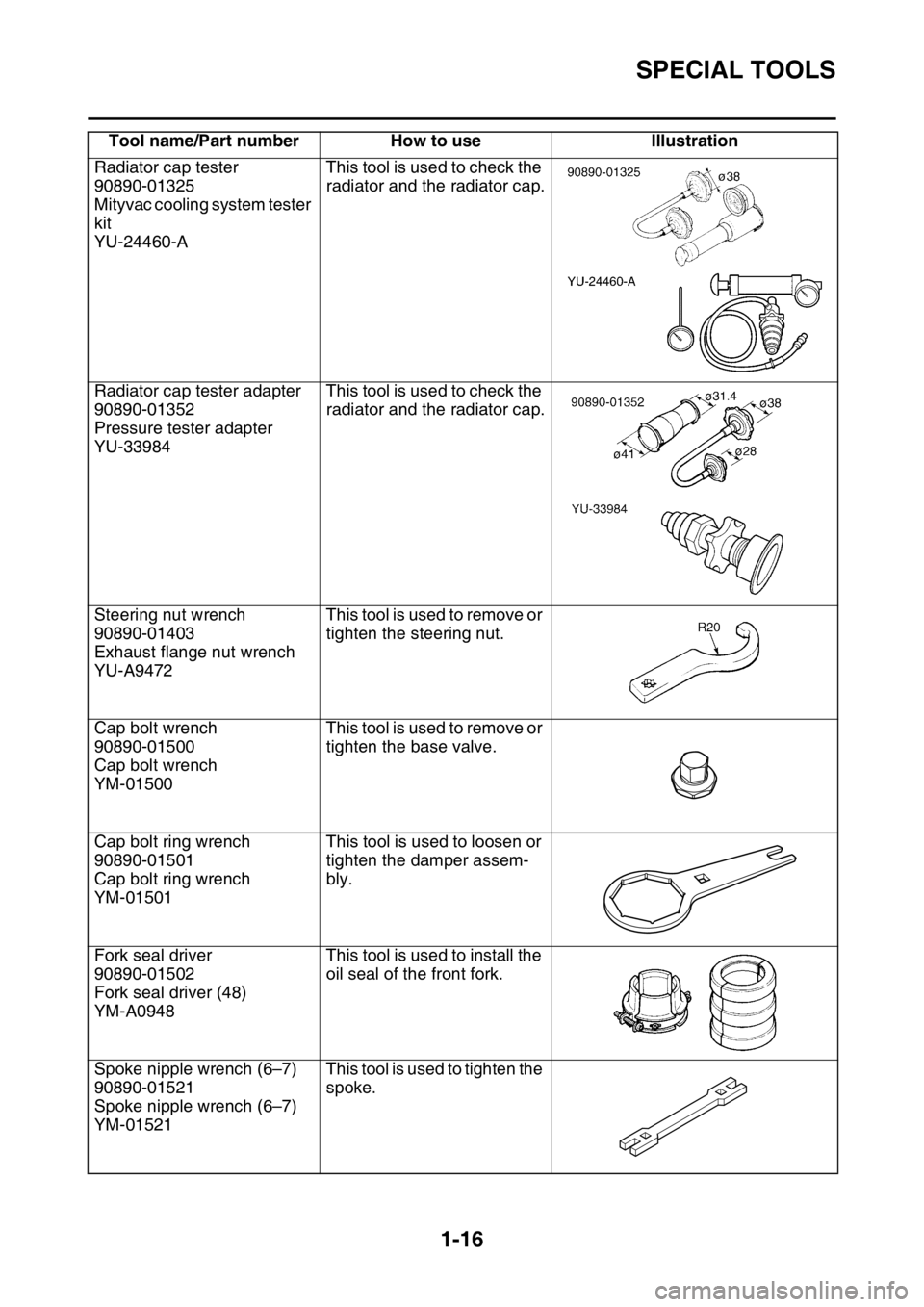
SPECIAL TOOLS
1-16
Radiator cap tester
90890-01325
Mityvac cooling system tester
kit
YU-24460-AThis tool is used to check the
radiator and the radiator cap.
Radiator cap tester adapter
90890-01352
Pressure tester adapter
YU-33984This tool is used to check the
radiator and the radiator cap.
Steering nut wrench
90890-01403
Exhaust flange nut wrench
YU-A9472This tool is used to remove or
tighten the steering nut.
Cap bolt wrench
90890-01500
Cap bolt wrench
YM-01500This tool is used to remove or
tighten the base valve.
Cap bolt ring wrench
90890-01501
Cap bolt ring wrench
YM-01501This tool is used to loosen or
tighten the damper assem-
bly.
Fork seal driver
90890-01502
Fork seal driver (48)
YM-A0948This tool is used to install the
oil seal of the front fork.
Spoke nipple wrench (6–7)
90890-01521
Spoke nipple wrench (6–7)
YM-01521This tool is used to tighten the
spoke. Tool name/Part number How to use Illustration
Page 57 of 430

ENGINE SPECIFICATIONS
2-2
EAS2GB2064
ENGINE SPECIFICATIONS
Engine
Engine type Liquid cooled 4-stroke, DOHC
Displacement 250 cm
3
Cylinder arrangement Single cylinder
Bore stroke 77.0 53.6 mm (3.0 2.1 in)
Compression ratio 13.5:1
Starting system Electric starter and kickstarter
Fuel
Recommended fuel Premium unleaded gasoline only
Fuel tank capacity 7.5 L (1.98 US gal, 1.65 Imp.gal)
Fuel reserve amount 1.6 L (0.42 US gal, 0.35 Imp.gal)
Engine oil
Lubrication system Wet sump
Recommended brand YAMALUBE
Type SAE 10W-30, SAE 10W-40, SAE 10W-50,
SAE 15W-40, SAE 20W-40 or SAE 20W-50
Recommended engine oil grade API service SG type or higher, JASO standard
MA
Engine oil quantity
Quantity (disassembled) 1.10 L (1.16 US qt, 0.97 Imp.qt)
Without oil filter element replacement 0.83 L (0.88 US qt, 0.73 Imp.qt)
With oil filter element replacement 0.85 L (0.90 US qt, 0.75 Imp.qt)
Oil filter
Oil filter type Paper
Bypass valve opening pressure 40.0–80.0 kPa (0.40–0.80 kgf/cm
2,
5.8–11.6 psi)
Oil pump
Oil pump type Trochoid
Inner-rotor-to-outer-rotor-tip clearance Less than 0.150 mm (0.0059 in)
Limit 0.20 mm (0.0079 in)
Outer-rotor-to-oil-pump-housing clearance 0.13–0.18 mm (0.0051–0.0071 in)
Limit 0.24 mm (0.0094 in)
Oil-pump-housing-to-inner-and-outer-rotor
clearance 0.06–0.11 mm (0.0024–0.0043 in)
Limit 0.17 mm (0.0067 in)
Cooling system
Radiator capacity (including all routes) 1.00 L (1.06 US qt, 0.88 Imp.qt)
Radiator capacity 0.56 L (0.60 US qt, 0.50 Imp.qt)
Radiator cap opening pressure 107.9–137.3 kPa (1.08–1.37 kg/cm
2,
15.6–19.9 psi)
Radiator core
Width 112.6 mm (4.43 in)
Height 235.0 mm (9.25 in)
Depth 28.0 mm (1.10 in)
Water pump
Water pump type Single suction centrifugal pump
Spark plug
Manufacturer/model NGK/LMAR8G
Spark plug gap 0.7–0.8 mm (0.028–0.031 in)
Page 103 of 430

3
PERIODIC CHECKS AND ADJUSTMENTS
PERIODIC MAINTENANCE............................................................................. 3-1
INTRODUCTION ........................................................................................ 3-1
PERIODIC MAINTENANCE CHART FOR THE EMISSION
CONTROL SYSTEM ................................................................................. 3-1
GENERAL MAINTENANCE AND LUBRICATION CHART ........................ 3-2
MAINTENANCE INTERVALS FOR COMPETITION USE ......................... 3-4
PRE-OPERATION INSPECTION AND MAINTENANCE................................. 3-9
GENERAL INSPECTION AND MAINTENANCE........................................ 3-9
ENGINE.......................................................................................................... 3-10
CHECKING THE COOLANT LEVEL ........................................................ 3-10
CHECKING THE COOLING SYSTEM ..................................................... 3-10
CHANGING THE COOLANT.................................................................... 3-10
CHECKING THE RADIATOR CAP .......................................................... 3-11
CHECKING THE RADIATOR CAP OPENING PRESSURE .................... 3-11
CHECKING THE COOLANT CIRCULATORY SYSTEM FOR LEAKS .... 3-12
ADJUSTING THE CLUTCH LEVER FREE PLAY .................................... 3-12
ADJUSTING THE THROTTLE GRIP FREE PLAY .................................. 3-13
LUBRICATING THE THROTTLE CABLE ................................................ 3-13
CLEANING THE AIR FILTER ELEMENT................................................. 3-14
CHECKING THE THROTTLE BODY JOINT ............................................ 3-15
CHECKING THE BREATHER HOSES .................................................... 3-15
CHECKING THE EXHAUST SYSTEM..................................................... 3-15
CHECKING THE FUEL LINE ................................................................... 3-16
CHECKING THE ENGINE OIL LEVEL..................................................... 3-16
CHANGING THE ENGINE OIL ................................................................ 3-17
ADJUSTING THE ENGINE IDLING SPEED ............................................ 3-18
ADJUSTING THE VALVE CLEARANCE ................................................. 3-19
CLEANING THE SPARK ARRESTER ..................................................... 3-23
CHASSIS........................................................................................................ 3-24
BLEEDING THE BRAKE SYSTEM .......................................................... 3-24
CHECKING THE BRAKE HOSE .............................................................. 3-25
ADJUSTING THE FRONT BRAKE .......................................................... 3-25
ADJUSTING THE REAR BRAKE ............................................................. 3-26
CHECKING THE FRONT BRAKE PADS ................................................. 3-26
CHECKING THE REAR BRAKE PADS ................................................... 3-28
CHECKING THE REAR BRAKE PAD INSULATOR ................................ 3-29
CHECKING THE BRAKE FLUID LEVEL.................................................. 3-29
ADJUSTING THE DRIVE CHAIN SLACK ................................................ 3-30
CHECKING THE FRONT FORK LEGS ................................................... 3-31
CHECKING THE FRONT FORK PROTECTOR GUIDE .......................... 3-31
CLEANING THE FRONT FORK OIL SEAL AND DUST SEAL ................ 3-31
AIR BLEEDING FROM FRONT FORK .................................................... 3-31
ADJUSTING THE FRONT FORK LEGS .................................................. 3-32
CHECKING THE SWINGARM OPERATION ........................................... 3-33
CHECKING THE REAR SUSPENSION ................................................... 3-33
Page 106 of 430

PERIODIC MAINTENANCE
3-2
EAS2GB2079GENERAL MAINTENANCE AND LUBRICATION CHART
NO. ITEM CHECKS AND MAINTENANCE JOBSINITIALODOMETER READ-
INGS
600 mi
(1000
km) or 1
month1800 mi
(3000
km) or 3
months3000 mi
(5000
km) or 6
months
1Clutch• Check operation.
• Adjust or replace cable.
2*Cooling sys-
tem• Check hoses for cracks of damage.
• Replace if necessary.
• Replace with ethylene glycol anti-
freeze coolant every 1 year.Every 1 year
3*Spark arrest-
er• Clean.
4*Front brake• Check operation, fluid level, and for flu-
id leakage.
• Replace brake pads if necessary.
• Replace brake fluid every 1 year. Every 1 year
5*Rear brake• Check operation, fluid level, and for flu-
id leakage.
• Replace brake pads if necessary.
• Replace brake fluid every 1 year. Every 1 year
6*Brake hoses• Check for cracks or damage.
• Replace. Every 4 years
7*Wheels• Check runout, spoke tightness and for
damage.
• Tighten spokes if necessary.
8*Tires• Check tread depth and for damage.
• Replace if necessary.
• Check air pressure.
• Correct if necessary.
9*Wheel bear-
ings• Check bearings for smooth operation.
• Replace if necessary.
10*Swingarm
pivot bear-
ings• Check bearing assemblies for loose-
ness.
• Moderately repack with lithium-soap-
based grease.
11Drive chain• Check chain slack/alignment and con-
dition.
• Adjust and lubricate chain with a spe-
cial O-ring chain lubricant thoroughly.Every ride
12*Steering
bearings• Check bearing assemblies for loose-
ness.
• Moderately repack with lithium-soap-
based grease every 1200 mi (2000 km)
or 12 months (whichever comes first).
Page 110 of 430
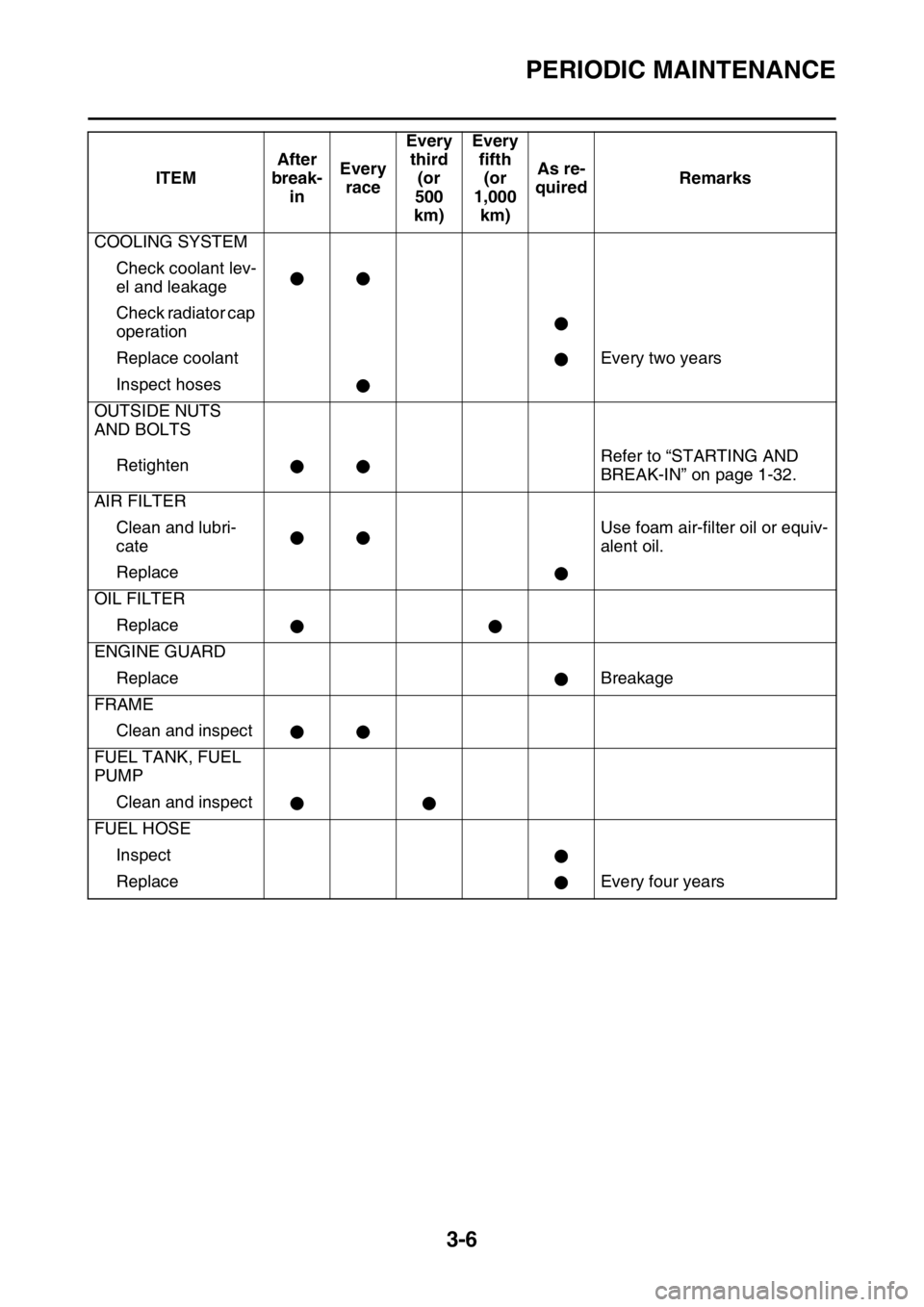
PERIODIC MAINTENANCE
3-6
COOLING SYSTEM
Check coolant lev-
el and leakage
Check radiator cap
operation
Replace coolant Every two years
Inspect hoses
OUTSIDE NUTS
AND BOLTS
RetightenRefer to “STARTING AND
BREAK-IN” on page 1-32.
AIR FILTER
Clean and lubri-
cateUse foam air-filter oil or equiv-
alent oil.
Replace
OIL FILTER
Replace
ENGINE GUARD
Replace Breakage
FRAME
Clean and inspect
FUEL TANK, FUEL
PUMP
Clean and inspect
FUEL HOSE
Inspect
Replace Every four yearsITEMAfter
break-
inEvery
raceEvery
third
(or
500
km)Every
fifth
(or
1,000
km)As re-
quiredRemarks
Page 113 of 430
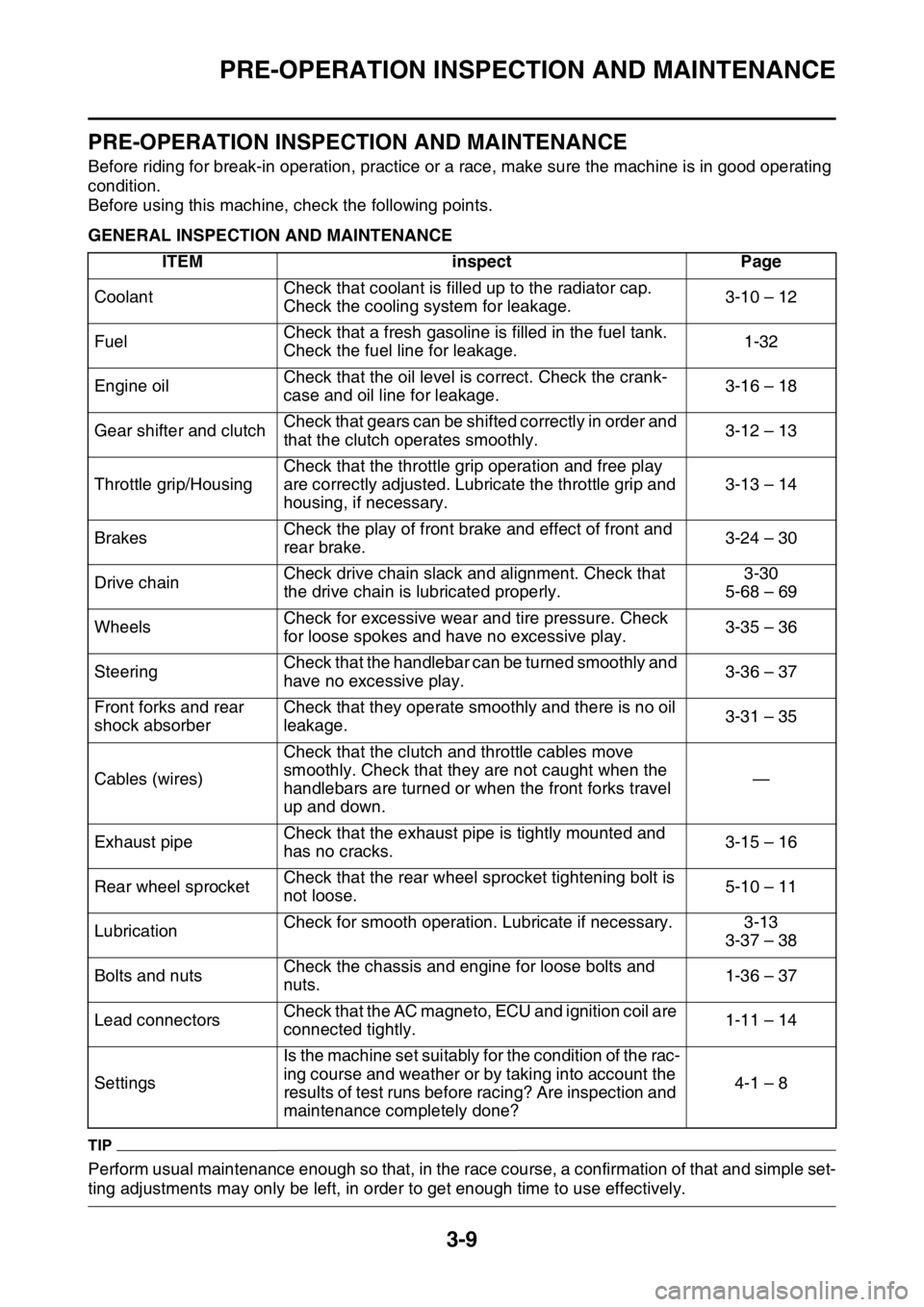
PRE-OPERATION INSPECTION AND MAINTENANCE
3-9
EAS2GB2081
PRE-OPERATION INSPECTION AND MAINTENANCE
Before riding for break-in operation, practice or a race, make sure the machine is in good operating
condition.
Before using this machine, check the following points.
EAS2GB2082GENERAL INSPECTION AND MAINTENANCE
TIP
Perform usual maintenance enough so that, in the race course, a confirmation of that and simple set-
ting adjustments may only be left, in order to get enough time to use effectively.ITEM inspect Page
CoolantCheck that coolant is filled up to the radiator cap.
Check the cooling system for leakage.3-10 – 12
FuelCheck that a fresh gasoline is filled in the fuel tank.
Check the fuel line for leakage.1-32
Engine oilCheck that the oil level is correct. Check the crank-
case and oil line for leakage.3-16 – 18
Gear shifter and clutchCheck that gears can be shifted correctly in order and
that the clutch operates smoothly.3-12 – 13
Throttle grip/HousingCheck that the throttle grip operation and free play
are correctly adjusted. Lubricate the throttle grip and
housing, if necessary.3-13 – 14
BrakesCheck the play of front brake and effect of front and
rear brake.3-24 – 30
Drive chainCheck drive chain slack and alignment. Check that
the drive chain is lubricated properly.3-30
5-68 – 69
WheelsCheck for excessive wear and tire pressure. Check
for loose spokes and have no excessive play.3-35 – 36
SteeringCheck that the handlebar can be turned smoothly and
have no excessive play.3-36 – 37
Front forks and rear
shock absorberCheck that they operate smoothly and there is no oil
leakage.3-31 – 35
Cables (wires)Check that the clutch and throttle cables move
smoothly. Check that they are not caught when the
handlebars are turned or when the front forks travel
up and down.—
Exhaust pipeCheck that the exhaust pipe is tightly mounted and
has no cracks.3-15 – 16
Rear wheel sprocketCheck that the rear wheel sprocket tightening bolt is
not loose.5-10 – 11
LubricationCheck for smooth operation. Lubricate if necessary. 3-13
3-37 – 38
Bolts and nutsCheck the chassis and engine for loose bolts and
nuts.1-36 – 37
Lead connectorsCheck that the AC magneto, ECU and ignition coil are
connected tightly.1-11 – 14
SettingsIs the machine set suitably for the condition of the rac-
ing course and weather or by taking into account the
results of test runs before racing? Are inspection and
maintenance completely done?4-1 – 8
Page 114 of 430

ENGINE
3-10
EAS2GB2083
ENGINE
EAS2GB2084CHECKING THE COOLANT LEVELEWA
WARNING
If coolant seems hot, do not remove the ra-
diator cap.
1. Stand the vehicle upright on a level surface.
2. Remove:
• Radiator cap “1”
3. Check:
• Coolant level
Maximum level “a” or below Add coolant
up to the maximum level.
ECA
NOTICE
• Adding water instead of coolant lowers the
antifreeze content. If, therefore, water is
used instead of coolant, check, and if nec-
essary, adjust the antifreeze concentra-
tion.
• Use only distilled water. However, if dis-
tilled water is not available, soft water may
be used.
4. Start the engine, warm this up for 3 minutes,
and then stop it.
5. Check:
• Coolant level
TIP
Before checking the coolant level, wait a few
minutes until the coolant has settled.
EAS2GB2085CHECKING THE COOLING SYSTEM
1. Remove:
• Seat
• Side cover (left/right)
• Air scoop (left/right)
Refer to “GENERAL CHASSIS” on page 5-
1.
• Air filter case cover
Refer to “THROTTLE BODY” on page 8-7.
2. Check:
• Radiator
• Radiator hoses
Crack/damage Replace.
Refer to “RADIATOR” on page 7-1.
3. Install:
• Air filter case cover
Refer to “THROTTLE BODY” on page 8-7.
• Air scoop (left/right)
• Seat
• Side cover (left/right)
Refer to “GENERAL CHASSIS” on page 5-
1.
EAS2GB2086CHANGING THE COOLANTEWA
WARNING
If coolant seems hot, do not remove the ra-
diator cap.
1. Place a container under the engine.
2. Remove:
• Coolant drain bolt “1”
3. Remove:
• Radiator cap
Slowly loosen the radiator cap to drain cool-
ant.
TIP
When the radiator cap is loosened, coolant will
gush out transversely; therefore, bring the con-
tainer near to the outlet.
4. Thoroughly flush the cooling system with
clean tap water.
1. Radiator
1
Page 115 of 430
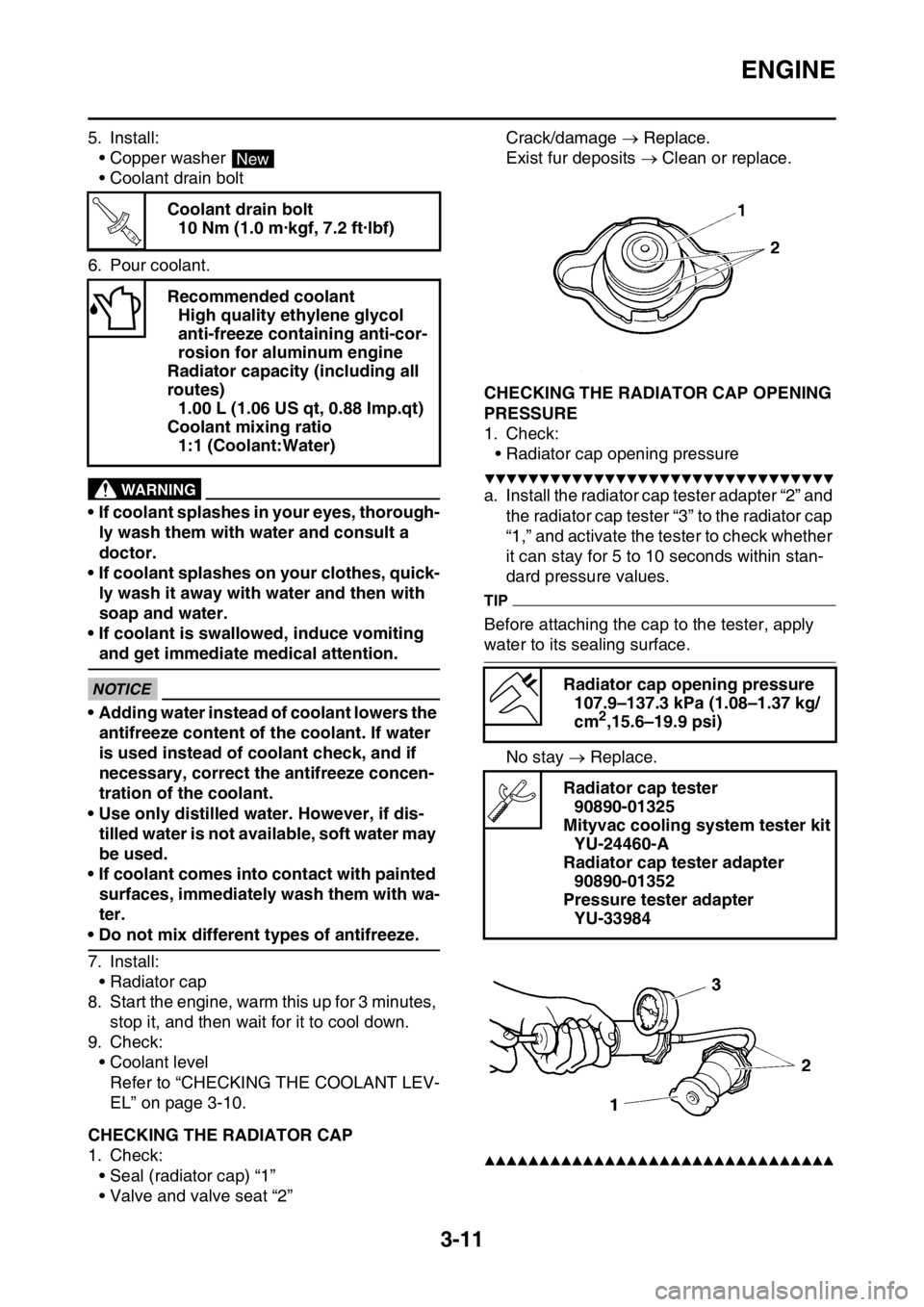
ENGINE
3-11
5. Install:
• Copper washer
• Coolant drain bolt
6. Pour coolant.
EWA
WARNING
• If coolant splashes in your eyes, thorough-
ly wash them with water and consult a
doctor.
• If coolant splashes on your clothes, quick-
ly wash it away with water and then with
soap and water.
• If coolant is swallowed, induce vomiting
and get immediate medical attention.
ECA
NOTICE
• Adding water instead of coolant lowers the
antifreeze content of the coolant. If water
is used instead of coolant check, and if
necessary, correct the antifreeze concen-
tration of the coolant.
• Use only distilled water. However, if dis-
tilled water is not available, soft water may
be used.
• If coolant comes into contact with painted
surfaces, immediately wash them with wa-
ter.
• Do not mix different types of antifreeze.
7. Install:
• Radiator cap
8. Start the engine, warm this up for 3 minutes,
stop it, and then wait for it to cool down.
9. Check:
• Coolant level
Refer to “CHECKING THE COOLANT LEV-
EL” on page 3-10.
EAS2GB2087CHECKING THE RADIATOR CAP
1. Check:
• Seal (radiator cap) “1”
• Valve and valve seat “2”Crack/damage Replace.
Exist fur deposits Clean or replace.
EAS2GB2088CHECKING THE RADIATOR CAP OPENING
PRESSURE
1. Check:
• Radiator cap opening pressure
▼▼▼▼▼▼▼▼▼▼▼▼▼▼▼▼▼▼▼▼▼▼▼▼▼▼▼▼▼▼▼▼
a. Install the radiator cap tester adapter “2” and
the radiator cap tester “3” to the radiator cap
“1,” and activate the tester to check whether
it can stay for 5 to 10 seconds within stan-
dard pressure values.
TIP
Before attaching the cap to the tester, apply
water to its sealing surface.
No stay Replace.
▲▲▲▲▲▲▲▲▲▲▲▲▲▲▲▲▲▲▲▲▲▲▲▲▲▲▲▲▲▲▲▲
Coolant drain bolt
10 Nm (1.0 m·kgf, 7.2 ft·lbf)
Recommended coolant
High quality ethylene glycol
anti-freeze containing anti-cor-
rosion for aluminum engine
Radiator capacity (including all
routes)
1.00 L (1.06 US qt, 0.88 Imp.qt)
Coolant mixing ratio
1:1 (Coolant:Water)
New
T R..
Radiator cap opening pressure
107.9–137.3 kPa (1.08–1.37 kg/
cm
2,15.6–19.9 psi)
Radiator cap tester
90890-01325
Mityvac cooling system tester kit
YU-24460-A
Radiator cap tester adapter
90890-01352
Pressure tester adapter
YU-33984
Page 116 of 430
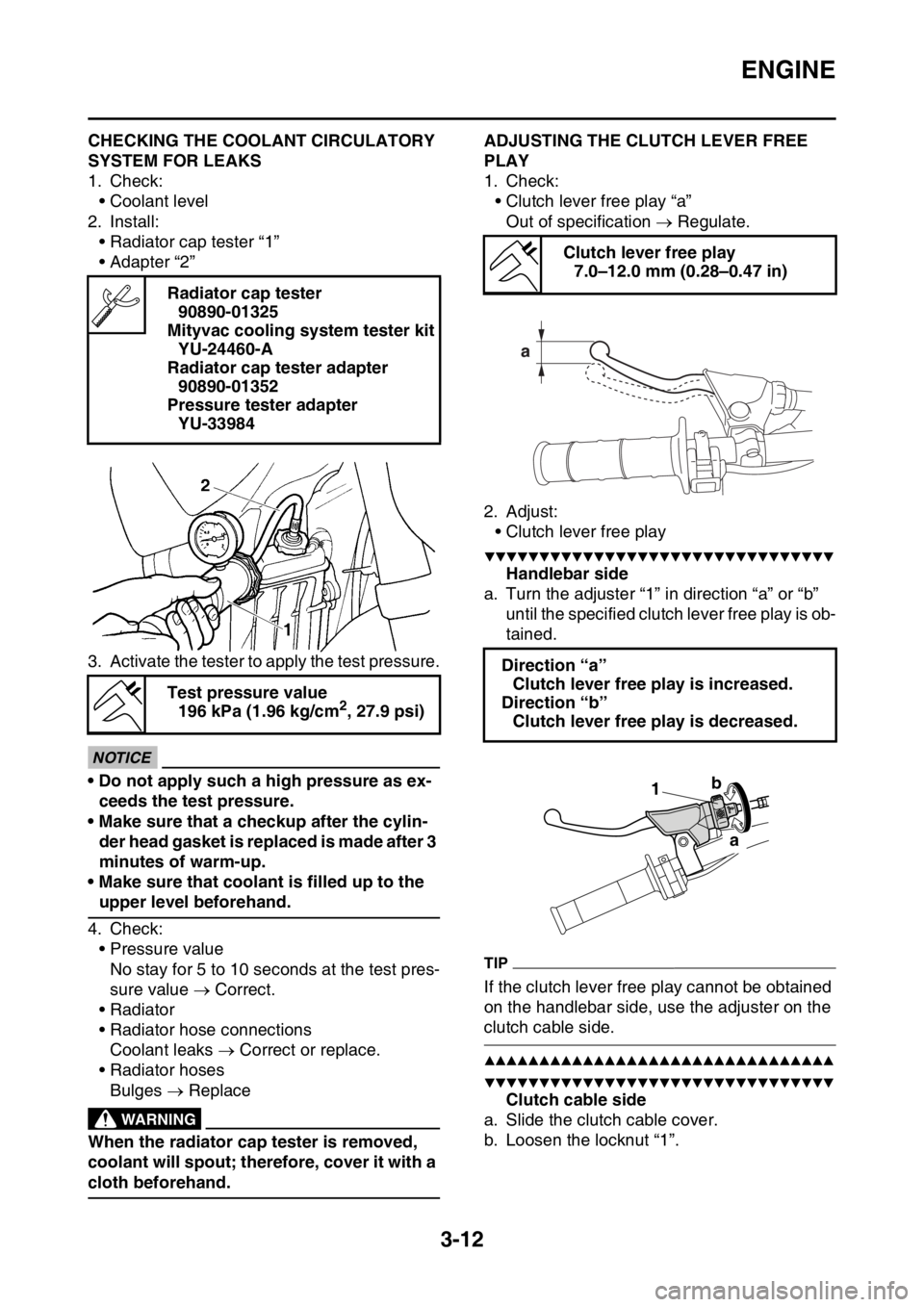
ENGINE
3-12
EAS2GB2089CHECKING THE COOLANT CIRCULATORY
SYSTEM FOR LEAKS
1. Check:
• Coolant level
2. Install:
• Radiator cap tester “1”
• Adapter “2”
3. Activate the tester to apply the test pressure.
ECA
NOTICE
• Do not apply such a high pressure as ex-
ceeds the test pressure.
• Make sure that a checkup after the cylin-
der head gasket is replaced is made after 3
minutes of warm-up.
• Make sure that coolant is filled up to the
upper level beforehand.
4. Check:
• Pressure value
No stay for 5 to 10 seconds at the test pres-
sure value Correct.
• Radiator
• Radiator hose connections
Coolant leaks Correct or replace.
• Radiator hoses
Bulges Replace
EWA
WARNING
When the radiator cap tester is removed,
coolant will spout; therefore, cover it with a
cloth beforehand.
EAS2GB2090ADJUSTING THE CLUTCH LEVER FREE
PLAY
1. Check:
• Clutch lever free play “a”
Out of specification Regulate.
2. Adjust:
• Clutch lever free play
▼▼▼▼▼▼▼▼▼▼▼▼▼▼▼▼▼▼▼▼▼▼▼▼▼▼▼▼▼▼▼▼
Handlebar side
a. Turn the adjuster “1” in direction “a” or “b”
until the specified clutch lever free play is ob-
tained.
TIP
If the clutch lever free play cannot be obtained
on the handlebar side, use the adjuster on the
clutch cable side.
▲▲▲▲▲▲▲▲▲▲▲▲▲▲▲▲▲▲▲▲▲▲▲▲▲▲▲▲▲▲▲▲
▼▼▼▼▼▼▼▼▼▼▼▼▼▼▼▼▼▼▼▼▼▼▼▼▼▼▼▼▼▼▼▼
Clutch cable side
a. Slide the clutch cable cover.
b. Loosen the locknut “1”. Radiator cap tester
90890-01325
Mityvac cooling system tester kit
YU-24460-A
Radiator cap tester adapter
90890-01352
Pressure tester adapter
YU-33984
Test pressure value
196 kPa (1.96 kg/cm
2, 27.9 psi)
Clutch lever free play
7.0–12.0 mm (0.28–0.47 in)
Direction “a”
Clutch lever free play is increased.
Direction “b”
Clutch lever free play is decreased.
a b
1